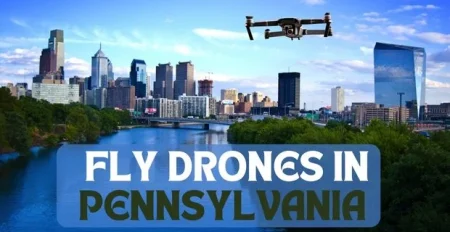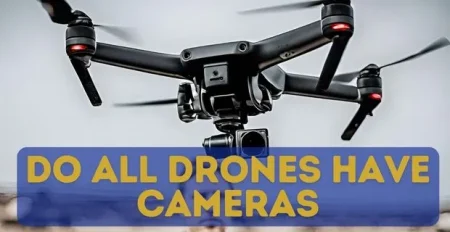
Police drones have become increasingly popular in law enforcement in recent years. These drones are equipped with various technologies, including high-resolution cameras, thermal imaging, and infrared sensors, making them valuable tools for police officers in various situations. However, one important question that comes to mind is how long can a police drone stay in the air.
How Long Can a Police Drone Stay in the Air
I first became interested in police drones during a visit to a law enforcement agency where I saw these amazing devices in action. As a technology enthusiast, I was fascinated by how these machines could capture aerial footage, monitor crowds, and even locate missing persons.
During my visit, I learned that battery life is critical in determining how long a police drone can remain airborne. This got me thinking about the different factors that affect flight time, the benefits of longer flight time, and the legal and ethical considerations that come with using police drones.
In this article, I will explore these issues in detail and answer some of the most common questions about police drone flight time. Whether you are a law enforcement officer, a drone enthusiast, or just someone interested in the technology, this article will provide you with valuable insights into the capabilities of police drones and their potential impact on law enforcement.
How do Police drones work?
Police drones are unmanned aerial vehicles (UAVs) that use various technologies to capture aerial footage and collect data in real-time. With advanced features such as high-resolution cameras, thermal imaging, and infrared sensors, these drones are well-suited for law enforcement purposes.
The components of a drone typically include a frame or chassis, motors, propellers, a power source (usually a rechargeable battery), and a control system that allows the operator to navigate the drone and control its movements.
Different types of drones are used for law enforcement, including fixed-wing drones and quadcopters. Fixed-wing drones are designed to fly longer distances and can cover more ground, while quadcopters are smaller and more maneuverable, making them better suited for urban environments.
Police Drone Flight Time
The flight time of a police drone varies depending on several factors, such as battery capacity, altitude, weight, wind speed, power consumption, temperature, flying conditions, flight maneuvers, payload, and battery health.
Generally, most police drones have a flight time of around 30-40 minutes, although some models can stay in the air for up to an hour. However, these flight times are subject to change based on the abovementioned factors.

Law enforcement agencies can maximize the flight time of their drones by selecting the appropriate model that best suits their needs, maintaining their batteries properly, and adhering to best practices when flying drones.
The following table is showing the flight time of some of the most famous police drone models:
| Police Drone Model | Flight Time | Drone Weight | Battery Capacity | Max Flight Speed |
| DJI Mavic 2 Enterprise | 31 minutes | 905g | 3850 mAh | 45 mph |
| DJI Matrice 200/210 | 38 minutes | 3290g | 4280 mAh | 51 mph |
| Yuneec H520 | 28 minutes | 1760g | 5250 mAh | 38 mph |
| Autel EVO II | 40 minutes | 1127g | 7100 mAh | 45 mph |
| Parrot Anafi USA | 32 minutes | 320g | 4350 mAh | 36 mph |
A drone’s weight and battery capacity can impact its flight time, while its maximum flight speed can affect its performance and versatility in different situations. By comparing these specifications, law enforcement agencies can choose the best drone for their specific needs and operational requirements.
Factors affecting the Flight time of Police Drones:
The flight time of a police drone is affected by several factors, including battery capacity, altitude, weight, wind speed, power consumption, temperature, flying conditions, flight maneuvers, payload, and battery health. By considering these factors, law enforcement agencies can choose the suitable drone for their needs and ensure that they maximize their flight time.
The flight time of a police drone depends on several factors, including.
Battery Capacity:
The flight time of a drone can be significantly impacted by its battery capacity, making it one of the most crucial factors to consider.
The larger the battery capacity, the longer the drone can stay in the air. Most police drones have a battery capacity that can provide a flight time of 30-50 minutes, although some models can stay in the air for up to an hour.
Weight:
The drone’s weight is another critical factor affecting flight time. Heavier drones require more power to stay in the air, reducing the flight time. A lighter drone can stay in the air for a longer period.
Flying Conditions:
Different flying conditions, such as rain or snow, can affect a drone’s flight time. Flying in harsh weather conditions can reduce the drone’s flight time due to increased power consumption and decreased stability.
Flight Maneuvers:
Different flight maneuvers can affect the drone’s power consumption, such as hovering, flying at high speeds, or accelerating and decelerating rapidly.
Payload:
Adding a payload, such as a camera or other equipment, to the drone can increase its weight and power consumption, reducing its flight time.
Wind Speed:
Strong winds can affect a drone’s flight stability, causing it to consume more power. The higher the wind speed, the more power the drone needs to maintain its stability and flight, resulting in a shorter flight time.
Power Consumption:
The drone’s power consumption rate is dependent on the drone’s flight speed, flight height, and payload weight. A higher power consumption rate can reduce the drone’s flight time.
Temperature:
Extreme temperatures can affect the drone’s battery life and performance. Flying a drone in hot weather can cause the battery to drain faster, resulting in a shorter flight time.
Altitude:
Higher altitudes require more power to maintain flight, impacting the drone’s flight time. Flying at higher altitudes can decrease the drone’s flight time due to increased power consumption.
Battery Health:
A drone’s battery may gradually lose capacity and efficiency as time passes. A well-maintained battery can provide longer flight times than a battery used extensively.
Benefits of Longer Flight Time
Having longer flight times for police drones can offer a range of benefits for law enforcement agencies, including
- Increased coverage area: Longer flight times mean that police drones can cover more ground and monitor larger areas.
- Enhanced surveillance: Drones with longer flight times can provide more detailed and comprehensive surveillance footage. Making them more effective crime prevention and detection tools.
- Cost savings: Longer flight times mean that police agencies can get more use out of their drones. Reducing the need for additional drones and associated costs.

Examples of Police Drone Usage
Police drones are used for various applications, including search and rescue, crowd control, and traffic monitoring. Here are some examples of how police drones are being used in various situations:
Search and rescue:
Using thermal imaging cameras on drones can aid in searching for missing individuals or those lost in remote or challenging-to-reach locations.
Crowd control:
Drones can monitor crowds and provide real-time information to law enforcement officials on the ground.
Traffic monitoring:
Drones can monitor traffic flow and detect accidents, enabling law enforcement to respond more quickly to emergencies.
Future of Police Drones
Advancements in drone technology are opening up new possibilities for law enforcement agencies. Some of the future developments in this field may include:
Integration with other technologies:
Drones may be integrated with artificial intelligence (AI) and other technologies to collect and analyze data in real-time.
Enhanced capabilities:
Future drones may be equipped with more advanced sensors, such as biometric sensors, enabling them to detect individuals under the influence of drugs or alcohol.
Greater autonomy:
Drones may become more autonomous, enabling them to operate without direct human control.
FAQs
Yes, police can use drones for surveillance purposes, but legal and ethical considerations must be considered.
“In the United States, the Fourth Amendment to the Constitution protects citizens from unreasonable searches and seizures by the government, including surveillance technology. “Therefore, police drone surveillance must comply with legal guidelines and regulations, such as obtaining a warrant in certain situations or following specific privacy protection protocols.
Additionally, using drones for surveillance raises ethical concerns regarding privacy, civil liberties, and the potential for abuse or misuse. Therefore, law enforcement agencies must have clear policies and procedures in place for the use of drones, as well as training and oversight to ensure compliance with legal and ethical standards.
Despite these considerations, drones can be useful for police surveillance in certain situations, such as during a search for a missing person or for surveillance of large public events. Drones can provide a high vantage point and real-time video footage, allowing police to gather information and monitor activities from a safe distance. However, the use of drones for surveillance must be carefully regulated and monitored to protect the rights and privacy of citizens.
The range of a police drone is influenced by several factors, including its drone type, battery capacity, radio frequency, and altitude. Generally, most police drones have a range of 1-7 kilometers (0.6-4.3 miles) and can fly up to 100-150 meters (328-492 feet) above ground level.
However, some high-end commercial drones range up to 10-15 kilometers (6.2-9.3 miles) and can fly at higher altitudes. The range and altitude of a drone can be affected by various environmental factors such as weather, terrain, and radio interference.
To extend the range of a police drone, some models may include features such as long-range antennas, cellular connectivity, or satellite communication. These features allow the drone to communicate with the operator from a greater distance or in areas with limited radio coverage.
It is important to note that laws and regulations regarding the operation of drones can vary by country and region. Therefore, police departments should consult with legal experts and adhere to local regulations when determining their drones’ range and flight capabilities.
Conclusion
Police drones are becoming increasingly important tools for law enforcement agencies. However, the flight time of these drones is a critical factor that affects their usefulness.
By understanding the factors that impact drone flight time, law enforcement agencies can choose the best drones for their needs and ensure they get the most out of their investment.
Additionally, it is important to consider the legal and ethical considerations of drone use in law enforcement and to establish clear guidelines for their use. As technology continues to evolve, it will be interesting to see how police drones can be used to enhance public safety and security.










